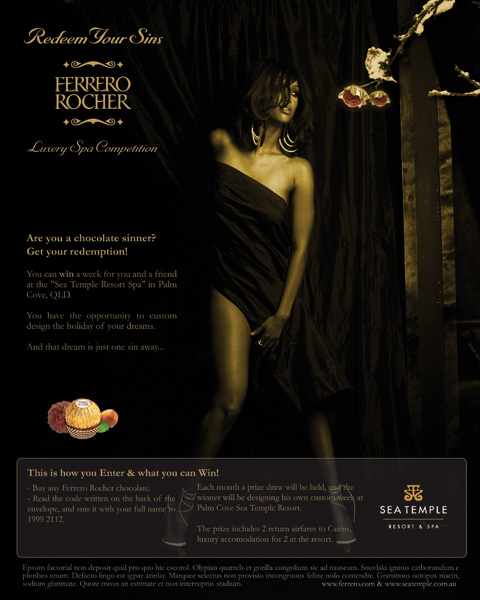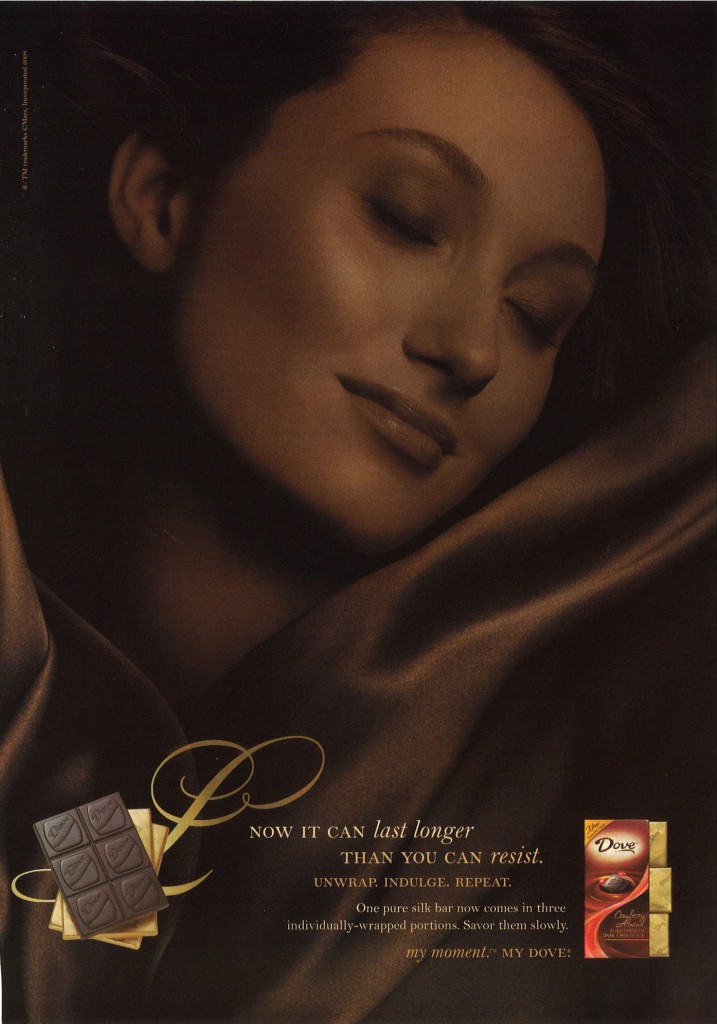Advertisers have mystified chocolate, portraying it as an intoxicant possessing the power to comfort, reward and satisfy women’s sexual desires. In doing so, these ads instruct the viewer to frame and interpret their own chocolate cravings in ways that overcome any resistance to consuming it.
To begin, consider this commercial for Dove:
Consider, also, this ad for Ferrero Rocher:
In particular, advertisers portray chocolate as satisfying female sexual desires. Such advertisements lead female viewers to understand their own desire for chocolate as a natural expression of their sexy femininity. The association of chocolate with luxury and the upper classes renders this sexuality socially acceptable. The symbolic sex is not that of the “crude lower class,” but the refined upper-class.
Text:
NOW IT CAN last longer THAN YOU CAN resist.
UNWRAP. INDULGE. REPEAT.
The misconception that chocolate is an aphrodisiac is exploited by these advertisements. The idea that chocolate contains chemicals that are similar to the mild-altering components found in ecstasy and marijuana, and evoke a feeling similar to falling in love, is now widespread. In actuality, studies have found that the amounts of these mood-enhancing chemicals are at such a low level that it is unlikely they lead to the euphoria that some feel when they consume chocolate. The findings of what could be called “chocolate propaganda research,” then, are negligible. Yet, marketing continues to perpetuate chocolate’s association with love and sex and its implied special relevance to women.
The association is so ubiquitous that it was mocked in an Axe commercial. Screenshot:
So why the insistence on indulgence?
Chocolate marketing must overcome the chief factor inhibiting women’s consumption: the fact that consumption of a fat, sweet food is inherently taboo for women, who are supposed to watch their weight. As a result, advertisers have replaced this food taboo with a sexual one. They have turned chocolate into a sexual, self-indulgent, private experience that invokes a taboo similar to that of masturbation. The intent is to equip her with an automatic inner-response to overcome her moment of self-restraint: the belief that chocolate consumption represents and enhances her femininity via satisfying her sexually, but tastefully, of course. Advertisers, then, overcome viewer resistance by shaping how they interpret and frame their own desires.
————————–
Jamal Fahim graduated from Occidental College in 2010 with a major in Sociology and a minor in Film and Media Studies. He was a member and captain of the Occidental Men’s Tennis team. After he graduated, Jamal moved from San Francisco to Los Angeles with the intention of working in the film industry as a producer. His interests include film, music, digital design, anime, Japanese culture, improvising, acting, and of course, chocolate!
If you would like to write a post for Sociological Images, please see our Guidelines for Guest Bloggers.




Comments 36
Taylor Wray — December 2, 2010
Sweet post (giggity giggity).
T — December 2, 2010
What is the takeaway of this post?
R Jackson — December 2, 2010
I'm surprised you don't mention race in your post -- it's an important aspect of much imagery involving white female sexual transgression, and seems relevant here.
K — December 2, 2010
Honestly commercials like that turn me away from chocolate. They're just a reminder of how orgasms are way better than candy.
The Nerd — December 2, 2010
For an amazing parody of the first video, watch this one by a feminist art student: http://www.youtube.com/watch?v=M-lFVpZBlRA
Jazz — December 2, 2010
I think the point about 'enhancing femininity' is important. The blunt association of chocolate with femininity, girliness, sexiness, etc, turns it into a gendered activity; proclaiming your love for chocolates is a way to proclaim yourself as feminine. You also then can in conversations berate yourself for being 'bad', which is much nicer than a discussion about why you earn less than your male counterparts I suppose.
It is incredibly symbolic. Whilst waiting for an extremely dreaded and anxiety-causing phone call on day, I ate half a family block (and all my nails) because the idea of chocolate as a 'comfort food' or a 'stress relieving food' was so entrenched in my mind, even though I *knew* it was just propaganda. If I were male, would I have reached for the chocolate? I'm not sure.
azizi — December 2, 2010
Okay, I'll bite...:o)
I don't like that sceen shot of the man being licked by those women because he looked like he was in blackface to me.
And one interpretation of that video could be "white girls love chocolate men" (as a person wrote on that YouTube video's comment thread).
Yeah I know-people are gonna think what they want to think. But given the racial realities of the USA (and elsewhere), it seems to me that the producers of this video would have been more culturally competent if one of the models licking that black man-excuse me, that chocolate man had been a Woman of color.
A — December 2, 2010
Firstly, I wonder if the "don't eat chocolate because it makes you fat" fits into this in a way more than just as a taboo. That is, to some extent you are supposed to be beautiful to achieve satisfying sexual relationships (though of course this isn't the only reason). So is saying "you can be satisfied by chocolate so you don't need to watch your weight" part of it?
Secondly, I think gendering chocolate is interesting because it could turn the male consumers away. Chocolate is seen as a feminine food, so perhaps boys are less likely to eat it. Have marketers attempted to make chocolate masculine in advertising? You know: "This is a MAN'S CHOCOLATE" the way they do with other things? I can't think of any examples, which surprises me.
alex :) — December 3, 2010
Nice. Another good reading in this vein is Hunger as Ideology by Susan Bordo.
Julie — December 3, 2010
I don't know about you all, but after seeing those ads, now I just feel like having some luscious, creamy, decadent chocolate. : )
JGH2 — December 3, 2010
Reminds me of how there is Pocky, in japan, and then there is also a "men's pocky".
April — December 3, 2010
What's really weird about this, is that all the real chocoholics I've known have been men!
My boyfriend always (always!) has a bar of chocolate in one of the butter-holders in the refrigerator. He restocks when running low.
T — December 3, 2010
Though I think the whole chocolate craze has to do more with the seven deadly sins than "weight gain." Lust and gluttony go hand-in-hand.
Village Idiot — December 3, 2010
The idea that chocolate contains chemicals that are similar to the mild-altering components found in ecstasy and marijuana, and evoke a feeling similar to falling in love, is now widespread. In actuality, studies have found that the amounts of these mood-enhancing chemicals are at such a low level that it is unlikely they lead to the euphoria that some feel when they consume chocolate.
There's a little more to it than that, or at least it's not an established fact that the effects widely associated with eating chocolate are placebo.
Some of the drugs/chemicals in chocolate inhibit the metabolization of others, acting as de facto potentiators of those chemicals; for example the anandamide in chocolate is also an endogenous cannabanoid naturally produced in our brains and the source of the claim that chocolate is like marijuana, but someone has to to eat 6-8 pounds of chocolate in a short time to gain a noticeable effect. However, two other chemicals in chocolate (couldn't find their names just now) are known to inhibit the breakdown of anandamide, allowing it to remain in the bloodstream much longer than it would remain by itself. So, there is a strong possibility that the anandamide in chocolate actually does exhibit noticeable effects to a consumer of a reasonably sized portio thanks to the effects of other chemicals present.
And like with any mood altering chemical, people's sensitivities vary considerably. The phenylethylamine in chocolate may not affect most people's moods as the majority of it obtained from chocolate is metabolized before reaching our central nervous system, but a small percentage of people are very sensitive to even small amounts of it (it's one of the chemicals naturally produced in our brains, is associated with feelings of being in love, and our natural level of it peaks during orgasm). Differing sensitivities might be why some people seem to be such chocolate fiends.
Also, the amount of chocolate most people eat when they're getting their fix is high enough in theobromine for most people to notice it's mood elevating and stimulating effect. It's also good for lowering blood pressure.
I'd like to know if the studies downplaying chocolate's mood altering effects studied chocolate the way it's consumed by most people or if each constituent chemical was tested on subjects individually since it's well known in pharmacology that many drugs inhibit, alter, or potentiate the activity of other drugs. Since chocolate is such a complex mix of chemicals it seems likely that at least some of the reported effects are due to synergistic interactions and others are likely sue to widely varying sensitivities among consumers.
And finally there's the whole issue of what constitutes "real" chocolate. My sister runs a chocolate shop and only uses high-grade dark chocolate, all natural ingredients and no preservatives, and since opening the shop her cholesterol and blood pressure have dropped to well within safe levels (they both used to be too high). I don't think that would've happened had she eaten the same amount of Hershey's or some other god-awful milk chocolate variety that's mostly fat, sugar, and milk so the question remains for me as to what type of chocolate the researchers used in their studies.
Truly dark chocolate (cocoa content above ~60% or so) has relatively little fat and sugar and may contain no dairy at all, and with it's high bioflavonoid content could arguably be labeled a health food. Sickly-sweet and high-fat milk chocolate (the kind generally preferred by the American palette) is a different beast entirely and in all probability merely gives consumers a brief sugar rush and then turns into body fat, at best.
Bess — December 5, 2010
Sarah Haskins of the brilliant segment Target Women does a funny send-up of this sort of advertising. Users in the USA can find it here:
http://current.com/shows/infomania/89789741_sarah-haskins-in-target-women-chocolate.htm
Kozoklikanje – Lioness, man and newborn cubs | rozakoza.com — December 10, 2010
[...] Seks i čokolada povezani u reklamnoj industriji [...]
Sssourabh — December 22, 2010
This is so true! I'm so over the decadent indulgences which, being a guy, alienates me from chocolate.. Which is why you'll see the non-mass market chocolatiers taking a more grassroots approach, plus tying in this whole green/organic/raw ingredients story to create quite a commendable story, which I covered on my recent visit to the Chocolate Show 2010.
http://sssourabh.wordpress.com/2010/12/07/chocolate-devotion/
Thanks for a great article!
Le mythe de la femme-chocolat | notachocolatecake — January 12, 2011
[...] association with love and sex and its implied special relevance to women » ( The Society Pages – « Sex and chocolate propaganda research » [...]
Carbohydrates Will Help Heal Your Broken Heart [Badvertising] | Blogging With The Stars — February 1, 2011
[...] particularly chocolate ones, are often advertised to women as indulgences they can use to overcome romantic disappointments, or [...]
Il cioccolato è un po' come il sesso, dice la pubblicità | Dissapore — February 8, 2011
[...] «Il marketing del cioccolato deve superare il fattore chiave che ne limita il consumo da parte delle donne: consumare un cibo grasso e dolce è di per sè un tabù per le donne, dalle quali ci si aspetta che tengano sempre a bada il loro peso. Per questo, i pubblicitari (…) hanno trasformato il cioccolato in un’esperienza privata, sessuale e autoindulgente”, come come scrive il blog (strepitoso) Sociological Images. [...]
Too Hot for Tots? « Baking With Ex Mix — June 27, 2011
[...] Eating chocolate is a normal albeit enjoyable experience, but advertisers seem to think that eating chocolate is an arousing experience (for women, anyway). Even when Mars attempts to be funny and innocent, [...]
O sexo do chocolate — March 20, 2013
[...] escolher entre um ou outro eu nunca entendi. Mas algumas explicações para o fenômeno existem. No Sociological Images, Jamal Fahim defende que as propagandas de chocolate tentam superar o tabu que é para as mulheres [...]
Breastfeeding is NOT a Sexual Act. Here's Why. - Pick Any Two — March 17, 2014
[…] of things that are decidedly not sexual and turn them around to make them about sex. Things like eating chocolate and cheeseburgers and drinking instant […]